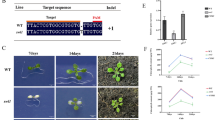Abstract.
The physiological properties of transgenic tobacco plants (Nicotiana tabacum L.) with decreased or increased transport capacities of the chloroplast triose phosphate/phosphate translocator (TPT) were compared in order to investigate the extent to which the TPT controls metabolic fluxes in wild-type tobacco. For this purpose, tobacco lines with an antisense repression of the endogenous TPT (αTPT) and tobacco lines overexpressing the TPT gene isolated from the C4 plant Flaveria trinervia (FtTPT) were used. The F. trinervia TPT expressed in yeast cells exhibited transport characteristics identical to the TPT from C3 plants. Neither antisense TPT plants nor FtTPT overexpressors showed a phenotype when grown in a greenhouse in air. Contents of starch and soluble sugars in upper source leaves were similar in TPT underexpressors and FtTPT overexpressors compared to the wild type at the end of the photoperiod. The FtTPT overexpressors incorporated more 14CO2 in sucrose than the wild type, indicating that the TPT limits sucrose biosynthesis in the wild type. There were only small effects on labelling of amino acids and organic acids. The mobilisation of starch was enhanced in αTPT lines but decreased in FtTPT overexpressors compared to the wild type. Enzymes involved in starch mobilisation or utilisation, such as α-amylase or hexokinase were increased in αTPT plants and, in the case of amylases, decreased in FtTPT overexpressors. Moreover, α-amylase activity exhibited a pronounced diurnal variation in αTPT lines with a maximum activity after 8 h in the light. These changes in starch hydrolytic activities were confirmed by activity staining of native gels. Activities of glucan phosphorylases were unaffected by either a decrease or an increase in TPT activity. There were also effects of TPT activities on steady-state levels of phosphorylated intermediates as well as total amino acids and malate. In air, there was no or little effect of altered TPT transport activity on either rates of photosynthetic electron transport and/or CO2 assimilation. However, in elevated CO2 (1500 μl · l−1) and low O2 (2%) the rate of CO2 assimilation was decreased in the αTPT lines and was slightly higher in FtTPT lines. This shows that the TPT limits maximum rates of photosynthesis in the wild type.
Similar content being viewed by others
Author information
Authors and Affiliations
Additional information
Received: 26 March 1999 / Accepted: 21 August 1999
Rights and permissions
About this article
Cite this article
Häusler, R., Schlieben, N., Nicolay, P. et al. Control of carbon partitioning and photosynthesis by the triose phosphate/phosphate translocator in transgenic tobacco plants (Nicotiana tabacum L.). I. Comparative physiological analysis of tobacco plants with antisense repression and overexpression of the triose phosphate/phosphate translocator. Planta 210, 371–382 (2000). https://doi.org/10.1007/PL00008145
Issue Date:
DOI: https://doi.org/10.1007/PL00008145




